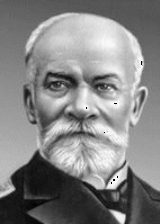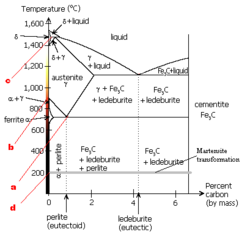
Dmitry Chernov
Encyclopedia

Yalta
Yalta is a city in Crimea, southern Ukraine, on the north coast of the Black Sea.The city is located on the site of an ancient Greek colony, said to have been founded by Greek sailors who were looking for a safe shore on which to land. It is situated on a deep bay facing south towards the Black...
) was a Russian metallurgist. He is known by his discovery of polymorphous
Polymorphism (materials science)
Polymorphism in materials science is the ability of a solid material to exist in more than one form or crystal structure. Polymorphism can potentially be found in any crystalline material including polymers, minerals, and metals, and is related to allotropy, which refers to chemical elements...
transformations in steel
Steel
Steel is an alloy that consists mostly of iron and has a carbon content between 0.2% and 2.1% by weight, depending on the grade. Carbon is the most common alloying material for iron, but various other alloying elements are used, such as manganese, chromium, vanadium, and tungsten...
and the iron
Iron
Iron is a chemical element with the symbol Fe and atomic number 26. It is a metal in the first transition series. It is the most common element forming the planet Earth as a whole, forming much of Earth's outer and inner core. It is the fourth most common element in the Earth's crust...
-carbon
Carbon
Carbon is the chemical element with symbol C and atomic number 6. As a member of group 14 on the periodic table, it is nonmetallic and tetravalent—making four electrons available to form covalent chemical bonds...
phase diagram
Phase diagram
A phase diagram in physical chemistry, engineering, mineralogy, and materials science is a type of chart used to show conditions at which thermodynamically distinct phases can occur at equilibrium...
. This discovery is the beginning of scientific metallography
Metallography
Metallography is the study of the physical structure and components of metals, typically using microscopy.Ceramic and polymeric materials may also be prepared using metallographic techniques, hence the terms ceramography, plastography and, collectively, materialography.-Preparing metallographic...
.
Biography
Chernov was born to a family of a feldsherFeldsher
Feldsher is the name of a health care professional who provides various medical services in Russia and other countries of the former Soviet Union, mainly in rural areas...
(registered nurse). In 1858 he graduated from the Petersburg Practical Technological Institute and worked for the Saint Petersburg Mint
Saint Petersburg Mint
Saint Petersburg Mint is one of the world's largest mints. It was founded by Peter the Great in 1724 on the territory of Peter and Paul Fortress, so it is one of the oldest industrial enterprises in Saint Petersburg....
. In 1859-1865 he was a lecturer and the museum keeper of the Petersburg Practical Technological Institute. From 1866 he was an engineer of the Obukhovsky Steel Foundry in Saint Petersburg. In 1880–1884 he explored the salt deposit near Bakhmach
Bakhmach
Bakhmach is a city located in the Chernihiv Oblast , in northern Ukraine. It is the administrative center of the Bakhmatsky Raion , and is located at around . As of January 1, 2005, the city's population is 20,300.-History:...
(currently Ukraine
Ukraine
Ukraine is a country in Eastern Europe. It has an area of 603,628 km², making it the second largest contiguous country on the European continent, after Russia...
). From 1884 he was with the Government Naval Committee (морской комитет). From 1886 he was the Chief Inspector of the Rail Road Department. From 1889 he was a Professor of the Mikhailovskaya Artillery Academy in Saint Petersburg.
Works

Polymorphism (materials science)
Polymorphism in materials science is the ability of a solid material to exist in more than one form or crystal structure. Polymorphism can potentially be found in any crystalline material including polymers, minerals, and metals, and is related to allotropy, which refers to chemical elements...
at different temperatures. He introduced different points known as Chernov's points:
- Point a at around 700 °C is the minimum temperature the steel should be heated to so it can be quenchQuenchIn materials science, quenching is the rapid cooling of a workpiece to obtain certain material properties. It prevents low-temperature processes, such as phase transformations, from occurring by only providing a narrow window of time in which the reaction is both thermodynamically favorable and...
ed. By the modern theory it is the temperature of austeniteAusteniteAustenite, also known as gamma phase iron, is a metallic non-magnetic allotrope of iron or a solid solution of iron, with an alloying element. In plain-carbon steel, austenite exists above the critical eutectoid temperature of ; other alloys of steel have different eutectoid temperatures...
eutectoid transformation (see the picture on the right). - Point b at around 900 °C is the temperature the steel should be heated to so to correct its crystalline structure. By the modern theory it is the maximal temperature when the ferriteFerrite (iron)Ferrite or alpha iron is a materials science term for iron, or a solid solution with iron as the main constituent, with a body centred cubic crystal structure. It is the component which gives steel and cast iron their magnetic properties, and is the classic example of a ferromagnetic material...
is stable. - Point c corresponds to the melting point of steel
- Point d at around 200 °C is the temperature needed to cool the steel to quench it. In modern theory it is known as the martensiteMartensiteMartensite, named after the German metallurgist Adolf Martens , most commonly refers to a very hard form of steel crystalline structure, but it can also refer to any crystal structure that is formed by displacive transformation. It includes a class of hard minerals occurring as lath- or...
transformation.
Chernov was able to correctly identify the reason for these points as polymorphic transformations in the steel and even draw the first sketch of what the phase diagram
Phase diagram
A phase diagram in physical chemistry, engineering, mineralogy, and materials science is a type of chart used to show conditions at which thermodynamically distinct phases can occur at equilibrium...
for the carbon-iron system may look like. Chernov published his results in the Notes of the Russian Technical Society of 1868. His article was named "Критический обзор статей гг. Лаврова и Калакуцкого о стали и стальных орудиях и собственные Д. К. Чернова исследования по этому же предмету" (Critical review of articles by Mr. Lavrov and Mr Kalkutzky about the steel and steel guns as well as own D.K. Chernov's research on this subject). Many authors consider the publication of this article as the date of transformation of metallurgy
Metallurgy
Metallurgy is a domain of materials science that studies the physical and chemical behavior of metallic elements, their intermetallic compounds, and their mixtures, which are called alloys. It is also the technology of metals: the way in which science is applied to their practical use...
from an art into a science.
Ten years later in 1879 Chernov published a monograph
Monograph
A monograph is a work of writing upon a single subject, usually by a single author.It is often a scholarly essay or learned treatise, and may be released in the manner of a book or journal article. It is by definition a single document that forms a complete text in itself...
named Research into the structure of the steel slabs where he described the major crystalline structures in steel and their effect on the properties of the slab. One type of steel crystal (dendrite) was named after Chernov.
Chernov contributed to the theory of the Siemens-Martin processs. He was one of the first to suggest usage of pure oxygen
Oxygen
Oxygen is the element with atomic number 8 and represented by the symbol O. Its name derives from the Greek roots ὀξύς and -γενής , because at the time of naming, it was mistakenly thought that all acids required oxygen in their composition...
in steel-making
Basic oxygen steelmaking
Basic oxygen steelmaking , also known as Linz-Donawitz-Verfahren steelmaking or the oxygen converter process is a method of primary steelmaking in which carbon-rich molten pig iron is made into steel. Blowing oxygen through molten pig iron lowers the carbon content of the alloy and changes it into...
. He also did research into the usage of direct reduced iron
Direct reduced iron
Direct-reduced iron , also called sponge iron, is produced from direct reduction of iron ore by a reducing gas produced from natural gas or coal. The reducing gas is a mixture majority of hydrogen and carbon monoxide which acts as reducing agent...
as well as contributed to the development of steel gun barrel
Gun barrel
A gun barrel is the tube, usually metal, through which a controlled explosion or rapid expansion of gases are released in order to propel a projectile out of the end at a high velocity....
s, armor-piercing shells
Armor-piercing shot and shell
An armor-piercing shell is a type of ammunition designed to penetrate armor. From the 1860s to 1950s, a major application of armor-piercing projectiles was to defeat the thick armor carried on many warships. From the 1920s onwards, armor-piercing weapons were required for anti-tank missions...
and emerging aviation
Aviation
Aviation is the design, development, production, operation, and use of aircraft, especially heavier-than-air aircraft. Aviation is derived from avis, the Latin word for bird.-History:...
.
He was one of the recognized leaders of steel manufacturing at the time. He was Chairman of the Russian Metallurgical Society, vice-president of the British Institute for Iron and Steel, an honorary member of the American Society of Mining Engineers, etc.

